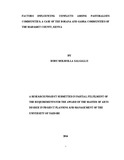| dc.description.abstract | Violent ethnic conflicts have been the cause of distress across many countries in the world, leading to human anguish through loss of lives and properties. Ethnic conflicts are not only common in developing countries, but are also problematic in the developed countries. In Marsabit County, pastoralist‟s conflict is not something unusual but a perennial issue. The purpose of the study was specifically set to find out causes of conflicts among the pastoralist communities in Marsabit. The study explored how factors like scarce natural resources, proliferation of fire arms, culture and local politics ignite conflicts among pastoral communities of Marsabit; namely between the Gabra and the Borana communities. The research objectives was; to establish the influence of natural resources on conflicts in Marsabit, to determine influence of porous border on conflicts, to establish ways in which culture influence conflicts and to determine how local politics influence conflicts between the Gabra and the Borana communities in Marsabit County. A descriptive survey was adopted to collect information, summarizes, present and interpret for clarification purposes, and this enabled investigation into the subject under study. For the purpose of this study respondents were drawn from two divisions (Gadhamoji and Turbi) with a total population of over 15,000. A location from each was selected through simple strata and random selection since both of the conflicting group, that is the Gabra and Borana live in the selected divisions and locations. Simple strata was helpful as it ensures inclusion in the sample of sub group which otherwise was to be omitted entirely by other sampling methods because of small numbers in the population. A sample size of 384 was considered for the study and random probability procedures were used to select the sample size and sampling procedures. The advantage of this random method was that every member of the population stood an equal chance of being picked, Mugenda & Mugenda (2003). A questionnaire and interview guide was used to get data from herders, politicians and village elders. The researcher used both the qualitative and quantitative data analysis techniques. Quantitative data was analysed using descriptive statistics and presented in form of percentages and frequencies while qualitative data was analysed narratively based on various study themes, the findings were; majority of the respondents indicated that lack of enough resources over which pastoralists compete prompt them to fight. Easy access of legally condemned weapons has also been intensifying pastoralists standoff. Conservative cultural practices where successful warriors are praised and rewarded have been scaling pastoralists conflict. Struggle for political supremacy was identified to have been increasing magnitude of pastoralists conflict. The study concluded that competition over limited natural resources as major cause of pastoralists conflict, where easy flow of weapons through physically porous border, culture praise and reward warriors and struggle for political supremacy also identified as factors that scale up rate of pastoralists‟ conflict in Marsabit. The study recommends for sharing of available resources, proper manning of country‟s borders to control arms flow, community elders to own peace initiatives with noble aim to unite different ethnic groups, and politicians to avoid inflammatory remarks. The study suggest for further study to be conducted on other causes of pastoralists conflict | en_US |



